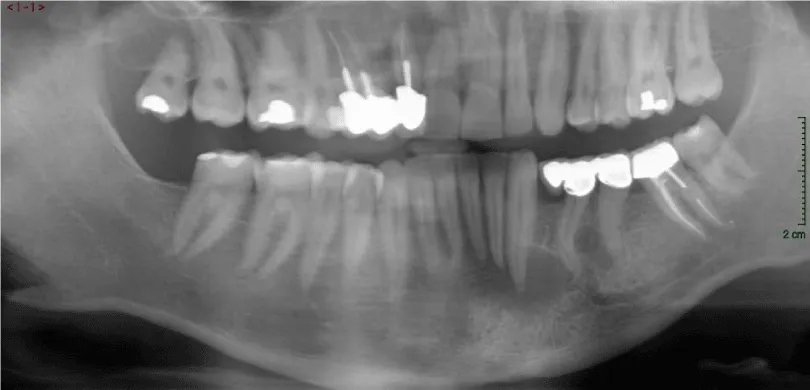Journal of Dental Problems and Solutions
Possible association between lesions of endodontic origin, infectogenomics and myocarditis
FM Abenavoli1*, AD Inchingolo2, G Dipalma2 and F Inchingolo2
2Department of Interdisciplinary Medicine, University of Bari, Italy
Cite this as
Abenavoli FM, Inchingolo AD, Dipalma G, Inchingolo F (2019) Possible association between lesions of endodontic origin, infectogenomics and myocarditis. J Dent Probl Solut 6(1): 011-012. DOI: 10.17352/2394-8418.000066Letter
Periodontal disease are chronic infectious disease in which bacteria initiate the host immune response determining at the end of a more or less time damage for tooth. In periodontitis, the clinical findings of bone resorption and loss of clinical attachment level around tooth are a result of inflammatory mediated alterations to the bone remodeling balance. The inflammatory infiltrate present between the plaque biofilm, bone and connective tissues regulate the host immune response to the bacteria.
The cause are multifactorial, local, systemic and genetic factors. Infectogenomics is a field of reserch that follow the association between genetic factors in pathogens colonization. The term “Infectogenomics” was introduced to define the effect of host genetic variants (most often single nucleotide polymorphisms, or SNPs). It is becoming increasingly clear that the microbial colonization depends on several factors including microbial virulence, lifestyle factors, environmental agents and also on the ability- largely genetically deter-mined- of the host to respond to the microbial challenge.
Certainly the bacterial plaque present is one of the original causes of the inflammatory process which then continues becoming chronic and causes an involvement of the para odontogenic structures. The intensity of the inflammation due to the activation of the response of the immune and inflammatory defense system derived from the host could determine an excessive inflammatory response due to a degenerative process and damage leading to clinical signs of periodontitis. The intensity of the inflammatory response is that determines the potential excessive inflammatory response cause of a degenerative and damage process leading to the clinical signs of periodontitis.
Another possibility could be the presence of localized pathological situations such as periodontal lesions. The presence of bacteria that have locally colonized the tissues could cause significant damage due to a particular genetic predisposition. In this case it could then also favor a situation of pathology in other organs
Several investigations have uncovered relationships between periodontal disease and cardiovascular disease [1-7] and periodontitis is suspected as a possible risk factor for some systemic and cardiovascular diseases.
Myocarditis is mostly caused by viral infections and rarely caused by bacterial pathogens. Association between odontogenic cyst and myocarditis then should be considered.
We recently encountered a case [8], of a previous healthy 43-year-old male that came to the emergency room with chest pain. His symptoms occurred after a period of fever and mandibular pain due to odontogenic infection. Clinical testing confirmed the diagnosis of myocarditis. In this case, therefore, the bacterial origin is very probable. The patient was submitted to surgical removal of the cyst (Figure 1) and the evolution was satisfactory.
It is extremely important that dentist or the specialist that receive a Patient with local mandibular pain, fewer and an history of odontogenic cyst remember the periodontal infectogenomics and its role in disease pathogenesis and its role in clinical application and immediately evaluate an appropriate therapy to avoid possible systemic complications.
- Aoyama N, Suzuki JI, Kobayashi N, Hanatani T, Ashigaki N, et al. (2017) Detrimental effects of specific Periodontopathic bacterial infection on tachyarrhythmia compared to Bradyarrhythmia. BMC Cardiovascular Disorders 17: 267. Link: https://bit.ly/2wyQ4nJ
- Schmitt A, Carra MC, Boutouyrie P, Bouchard P (2015) Periodontitis and arterial stiffness: a systematic review and meta-analysis. J Clin Periodontol 42: 977-987. Link: https://bit.ly/2Ms79Lb
- Humphrey LL, Fu R, Buckley DI, Freeman M, Helfand M (2008) Periodontal disease and coronary heart disease incidence: a systematic review and Metaanalysis. J Gen Intern Med 23: 2079-2086. Link: https://bit.ly/2EQTpmX
- Bahekar AA, Singh S, Saha S, Molnar J, Arora R (2007) The prevalence and incidence of coronary heart disease is significantly increased in periodontitis: a metaanalysis. Am Heart J 154: 830-837. Link: https://bit.ly/2wGVRHT
- Hujoel PP, Drangsholt M, Spiekerman C, DeRouen TA (2000) Periodontal disease and coronary heart disease risk. JAMA 284: 1406-1410. Link: https://bit.ly/2WjvPdb
- DeStefano F, Anda RF, Kahn HS, Williamson DF, Russell CM (1993) Dental disease and risk of coronary heart disease and mortality. BMJ 306: 688-691. Link: https://bit.ly/2ER00xD
- Caplan DJ, Chasen JB, Krall EA, Cai J, Kang S, et al (2006) Lesions of Endodontic Origin and Risk of Coronary Heart Disease. J Dent Res 85: 996-1000. Link: https://bit.ly/2QKWc5z
- FM Abenavoli, AD Inchingolo, G Dipalma, F Inchingolo (2018) Periodontal Neoformations, Myocarditis Onset: is it more than a simple coincidence? Journal of Biological Regulators & Homeostatic Agents (In Press).
Article Alerts
Subscribe to our articles alerts and stay tuned.
 This work is licensed under a Creative Commons Attribution 4.0 International License.
This work is licensed under a Creative Commons Attribution 4.0 International License.


 Save to Mendeley
Save to Mendeley
